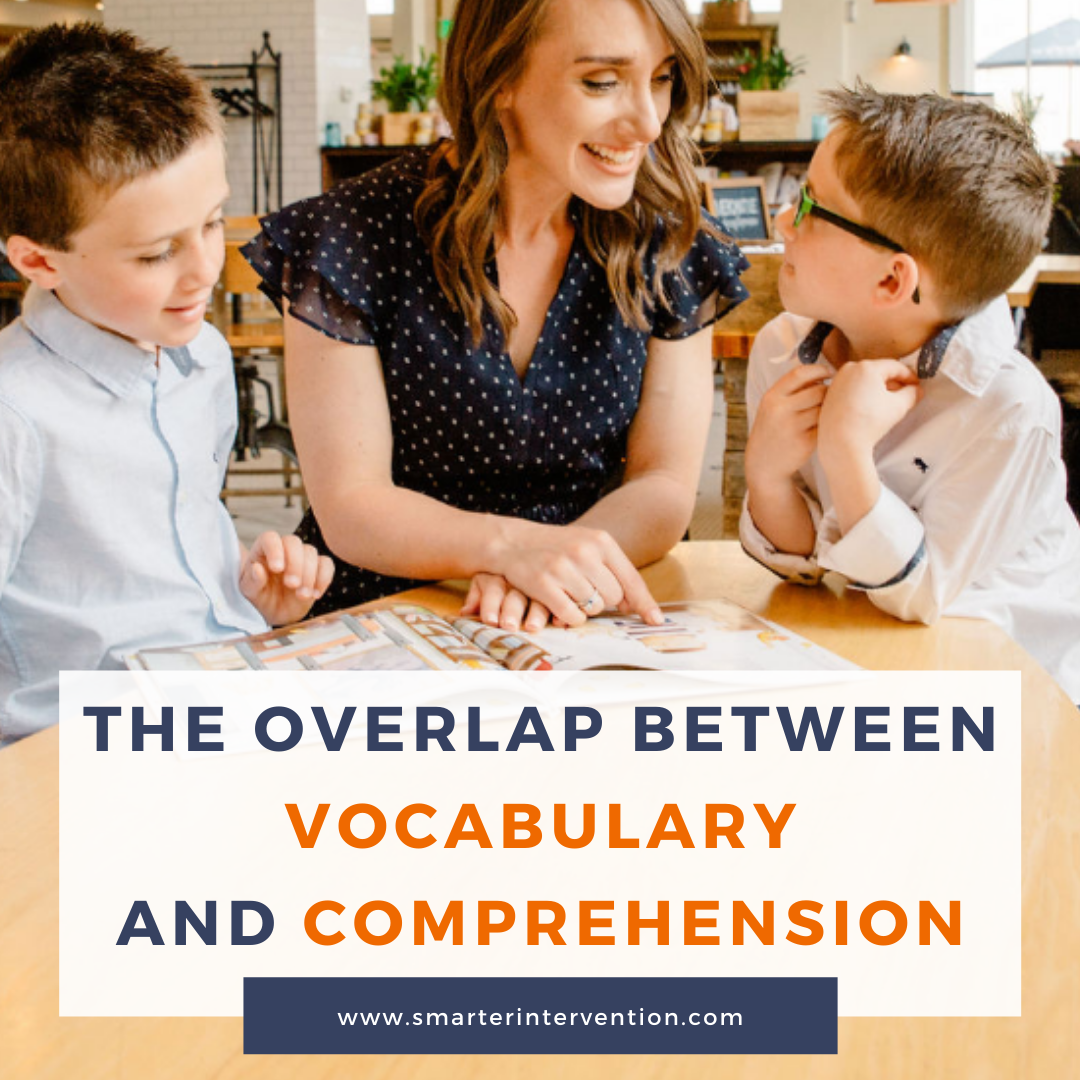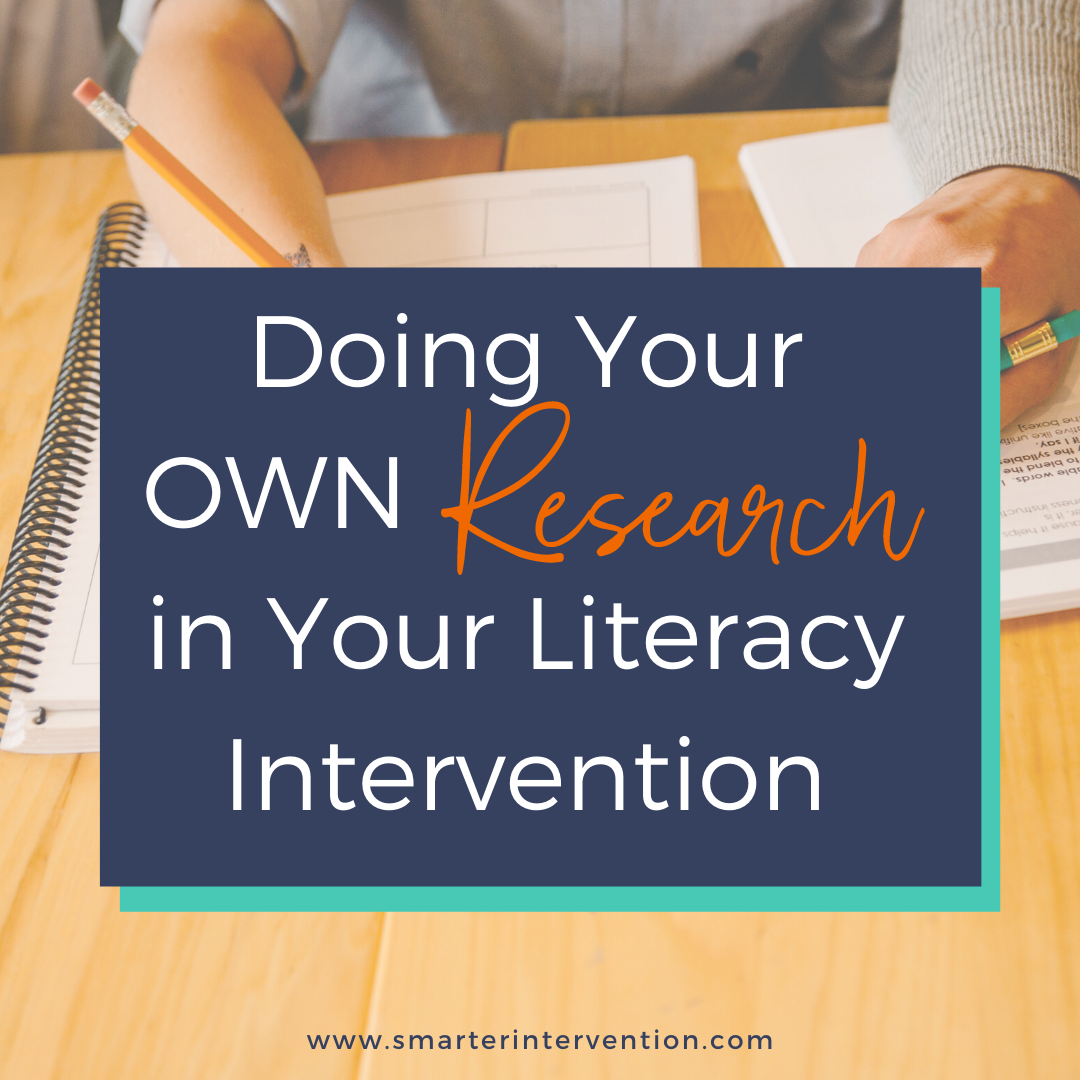Science-based literacy resources and articles
for families, educators and schools
Search by Category:
Categories
- Advocacy
- Authentic Literature
- Business
- Comprehension
- Data Tracking
- Differentiation
- Dyslexia
- Evaluation and Assessment
- Executive Functioning
- Games & Activities
- Helping My Child At Home
- How To
- IEP/504 Plan
- Lesson Planning
- Math
- Online Intervention
- Organization
- Parents
- Phonics
- Phonological Awareness
- Reading Comprehension
- Reading Fluency
- Research
- SLP
- Spelling
- Vocabulary
- Writing
The Overlap Between Vocabulary and Comprehension
So often, my students struggle with the main idea and key details because they are either WAY too broad, WAY too specific, or start talking in the longest run-on sentence trying to tell me every last detail about the passage they can squeeze in.
Recently, I have found that it has actually been a vocabulary activity that has allowed me to explicitly teach them how the ideas in the stories and passages we read come together to form the main idea and key details.
Vocabulary is More than Morphology
Don’t get us wrong - we fully believe that morphology is important! In our program, we have two full levels devoted to morphology.
We need to recognize, however, that morphology is only a very small piece of vocabulary and we need to be explicitly teaching vocabulary with ALL of our students, regardless of age or level. Read on to learn exactly what vocabulary instruction needs to include to support vocabulary development.
How to Teach Writing in Your Literacy Intervention Lessons
One of the most common questions we get is “how do I teach writing?”
In EVERY lesson that we teach students, we work through the 5-Core Components of Literacy for reading and then go back through each of them for writing. Keep reading to learn the actual strategies we use to seamlessly weave explicit, systematic writing instruction into our lessons.
Where Do Students Need Explicit Instruction?
Students struggle for different reasons and in different capacities. In order to truly support our struggling readers, we must not only understand why students are struggling but also -
Where are students struggling to read specifically?
Which specific areas are causing students to be ineffective readers? Because the bottom line is if we are trying to support struggling readers, we need to stop applying one-size-fits-all approaches and we need to know what type of support is needed to get our struggling readers on track. Keep reading to learn more!
All About Graphic Organizers
Graphic organizers are visual displays and incredible tools to help your students with writing and comprehension. Graphic organizers can also be called mind maps, concept maps, or concept webs, but they all have the same wonderful purpose - to solidify comprehension. Graphic organizers explicitly teach students how to connect and organize information. They visually show what information to prioritize as well as help students with brainstorming and connecting any background information.
What Students Need for Effective Comprehension & Writing in the Classroom
Today, we’re diving right into a pretty loaded topic! We wanted to start the conversation around what students need in order to effectively comprehend lessons in the classroom and what they need to be able to write effectively to demonstrate their knowledge.
Now obviously, this isn’t something we can fully communicate/solve in a single blog post. But … we do have a really good starting point! And, don’t worry, we also have some really good follow-up coming your way!
The Key to Advocating for Your Students in IEP Meetings
Have you ever felt dismissed, talked over, or doubted in your intervention? When I walked out of the school after my first IEP meeting, I had this awful feeling of defeat knowing that I wasn’t taken seriously, but worse, I wasn’t able to advocate for my student they way I wanted to and knew I could. Keep reading to learn about the key to advocating for your students in IEP meetings.
The 3 Things Your Literacy Intervention Materials MUST Include
In this field, we are bombarded with theories, approaches, information and often, it can be difficult to know exactly what resources you need.
Whether you are looking for activities to supplement a program that your school has provided you with, or, you are looking for a comprehensive curriculum, there are a few things that you should always be looking for. Keep reading to learn more…
Addressing Overwhelm and the Need to be Perfect in Your Intervention
Last spring, so many of us had to make an abrupt switch to online learning. It was expected that this transition be seamless, and for so many, it was quite the opposite of that. Let’s be honest, it was hard. We weren’t sure how we were going to make online learning effective, how to transition all materials to be used virtually, and the hardest part… we weren’t able to see our students in person anymore. It was tough. But, over time we were able to adapt. We came up with ways to transition materials to an online format and continued to hold our connections with our students even though we weren’t with them. We were finally starting to feel comfortable when everything changed again…
How Data-Tracking Makes Classrooms Equitable
As educators we are capable of changing the world - one of the best ways we can continue doing this is by leveling the playing field for our students, so every child can be as successful as they can be. In order to level the playing field, we must have clarity around our students’ strengths and difficulties and we must make sure that we’re able to understand this in an equitable way. Educational equity is absolutely crucial because it gives equal opportunities to children. Data-tracking can help set us up for educational equity - keep reading to learn more about educational equity and how data-tracking can help us make our classrooms more equitable for all of our students.
Doing Your OWN Research in Your Intervention
As literacy interventionists, we are told all the time about the importance of “research-based” intervention but no one tells us that this should include our own research! Click through to read more.
The Wrong Ways to Use Data
When we are trying to determine which areas we should focus on with our students we are using our data to provide a guide, a roadmap.
But one of the biggest mistakes we see (we know because we’ve been there) is that we aren’t using data to drive decisions because of two big blocks.
The Common Literacy Intervention Belief that Could Be Holding You Back!
Assuming a program, even an evidence-based program, works for all students without tracking your own data and adjusting as needed, puts students at risk to continue falling through the cracks. Click the image above to read more about a common belief that may be holding you back in your intervention.
How to Track Literacy Data Digitally
While 2020 was an interesting year to say the least, we were glad to have learned so many lessons. One of which, was how to stay organized in a completely digital space. We transitioned lessons to a completely digital format, student interaction, you name it! And with all the changes, we realized Tracking data digitally was another great way to communicate students’ growth and what was happening in our sessions with our students’ parents and with our colleagues. Today, we wanted to walk you through how we track our literacy data in a digital format!
The Missing Piece in the Data-Tracking Process
One of the biggest mistakes we see in intervention is when interventionists take all of this time to collect wonderful data, but then not effectively sharing it with those who have a vested interest in the results - click here to read more about how you can EASILY share your results and grab a FREE resource that will help you do so!
How to Analyze your Literacy Intervention Data
We are back again with the next step in Data Tracking! This week we are talking all about analyzing your data. Now, we know that the word analyze brings about a heavy weight - but hear us out. Analyzing your data doesn’t have to be hard. One of the biggest mistakes we see is when well-meaning interventionists and SLPs rely on evidence/research based programs without analyzing their own data to make sure that students are actually making growth.
How to Organize Your Session in a Way That Makes Data Tracking EASY
We know that data and data-driven instruction are CRITICAL to effective intervention so a few weeks ago we asked if you all would be interested in a free training around the subject of taking and using data in your lessons. The response was an overwhelming yes. That’s where “Data-Tracking December” was born. All month long, we will be releasing our data-tracking trainings and want to invite you to take this information (and a free resource - stay tuned next week!) and implement it in your sessions so that you can easily get students the results you have always wanted for them.
How To Collect Reading Intervention Data
It’s Data-Tracking December! All month long we will have blogs and video trainings for you related to the 4 biggest mistakes we’ve made in data-tracking. If you are looking for a way to better track your intervention data or you’re hoping to understand how to use that information more effectively to drive your instruction, then stay tuned because these next four weeks will deliver exactly what you are looking for.
















